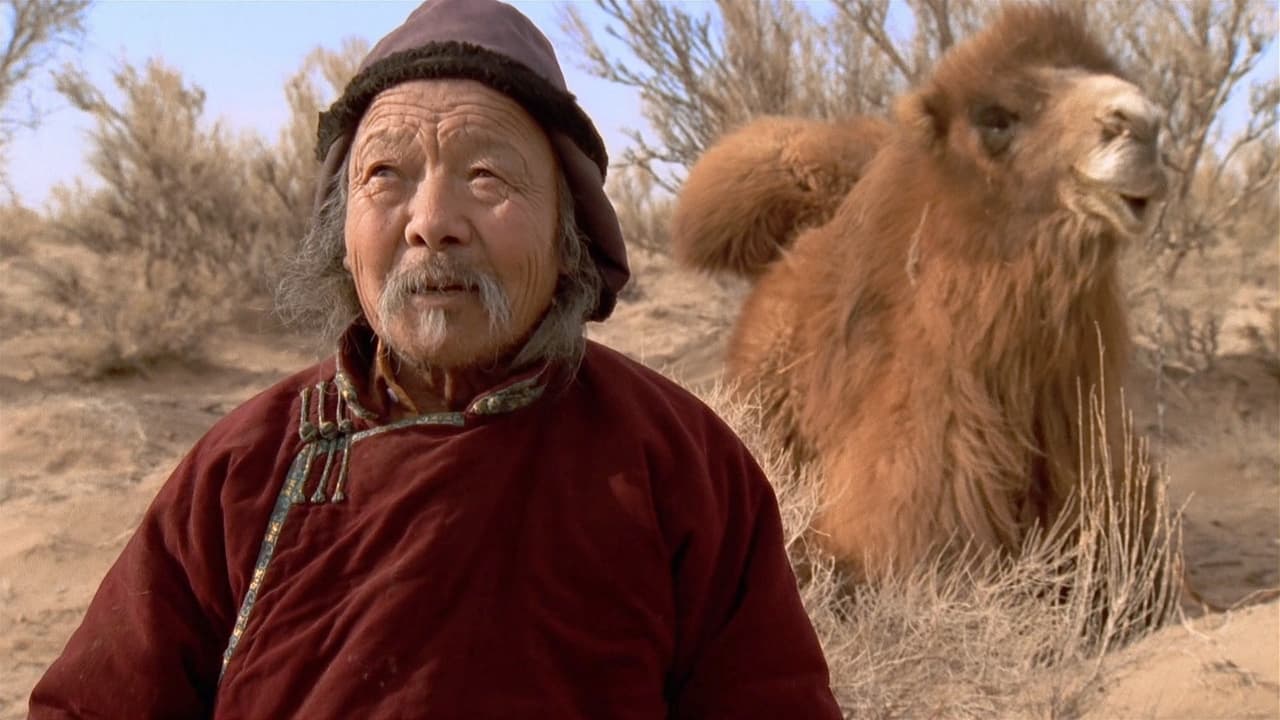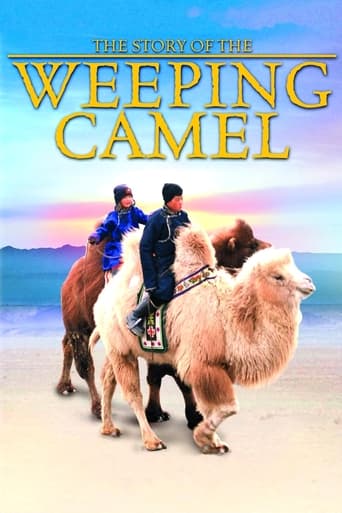

At the beginning of The Story of the Weeping Camel, a film that chronicles the daily life of a family of shepherds in the Gobi Desert of Mongolia, one of the elders tells the story of the weeping camels. At one time, he says, a camel loaned his antlers to a deer but they were never returned causing the camels to look to the horizon with tears in their eyes, hoping that their antlers will be returned. It is the spring and the time for camels to give birth. One of the camels has a painful birth and the family members help the distraught camel by pulling a beautiful white colt from her womb.Almost immediately, it seems that the camel has rejected her young for reasons unknown but perhaps because it was such a difficult delivery. Although the members of the clan make every effort to bring the mother and her offspring who they have named "Botok" together, their efforts produce no results and the picture of the baby wandering alone longing for his mother is heartbreaking. The film, however, is not a sad one. It radiates the purity of the simpler life that has gone on for centuries and the ties that nurture a family, their responsibilities and the traditions that they share. Great grandmother Chimed cooks the milk and cares for the family's young granddaughter while her mother Odgoo works with the animals and the family treats the young lambs as pets.Nothing works to bring mother and baby camel together until an ancient ritual is performed. The family's two young sons Dude and Ugna are sent on a trip by camel of what appears to be several miles to the regional tribal center at Aimak. There they request that the music teacher come to their tents to perform a ritual where the teacher will play the violin and the boys' mother will sing to the camel. The ritual was learned by Luigi Falorni, a film student in Germany, from a fellow student, a Mongolian, and they both traveled to the Far East to make the film, in the tradition of Robert J. Flaherty's Nanook of the North.At Aimak, the boys are introduced to a touch of the modern world - TV, motorcycles, and computer games. Ugna buys an ice cream and batteries for his grandfather and when he comes home, he sheepishly asks his family if they would buy him a TV. The ritual performed by the family and the music teacher highlights the healing traditions that families in the area have used for hundreds of years and it is soothing and quite beautiful. The Story of the Weeping Camel is very slow, perhaps too slow for some children, yet is a wonderful learning experience of nurturing and how other cultures live, the feeling of community, and how healing can be performed in ways other than taking two pills before bedtime.
... View MoreI truly feel sorry for those viewers - of a younger generation, no doubt - who are products of a culture whose main purpose seems to be the constant diminishing of attention spans. This is indeed a slow and long-breathed story whose pace matches the vast spaces and ancient culture of the people portrayed. I stumbled on this charming, touching, and humorous film purely by accident this morning, drawn by its fetching title. As soon as I tuned in I could not take my eyes off it. It is true that we are drawn by the strangeness of the way of life of these people, but the film makers have done a superb job of showing us how, in so many ways, these people and their families are so much like us, stressing our common humanity. The film makers made the admirable decision not to include a voice-over narration, allowing events and the words of the people involved to tell the story, as sparse as it is. But then "story" is not the point of this movies, although the central plot line of a mother camel who rejects her calf is certainly sufficient to make it all hang together. I also - although far from being a guilty green liberal felt a twinge of sadness abd regret to see the accoutrements of Western consumer culture slowly insinuating themselves into these people's lives. I really cringed when young Ugna asked his father for a TV for their tent.This is really a grownup film, and perhaps it appeal is - sadly - to a more mature and intelligent audience, but it is a real sleeper not to be missed.
... View MorePerhaps one year ago I saw this film in Sydney at an independent theater (Where else)! I did enjoy it very much since I spent my early life in rural area then my early working life in small dairy-farms that today would also be obsolete. The reason I mention this is because I just watched "the cave of the yellow dog" and to me it resemble very much as a sequel to "weeping camel". If you like one I really think you should not miss the other. Well written comments I'm sure have told you what it's all about and I can't imagine anyone seeing spoiler in being told what it is. Just this the life in nomadic Mongolia a life that has its days counted, but a beautiful though hard life. I'm sorry that one comment suspected some ulterior agenda in the making of these films such as tourism promotion and I would find it hard to argue with its author who claims to be Mongol and have no reason to doubt he is. He thought the translation was somehow manipulative, at least that's what I understood. This is always a problem when one knows more than what is expected. Just the same as those with knowledge of how movies and special effect are made, well it's hard for them to enjoy the result. When I see french movies with English subtitles and read the translation I often can see it does not convey, and can not convey the feeling it was intended to convey in the original language. I think there is little that can be done about this. Yet this is also what makes different cultures so attractive and one has to invest a little in some curiosity to understand the subtlety although there is no guaranty to get it 100% right. I think there is no much gain in trying to analyse too much such work, not that it should not be done, simply if you're seeking enjoyment it's there and all you have to do is go with the flow and you will be rewarded. MB
... View MoreI was entranced by this movie. When the young camel's mother rejected the baby, which was white and rare, the mother sent these two young boys across the the bare country with only the power line as their guide, to fetch the "fiddler", I had no idea what to expect. Well, they found the fiddler, and he promised to show up in a few days, which he did-on the back of a friend's motorcycle. He took his "fiddle', which looked like a converted cigar box, over to the mama camel, played a few different notes until the camel started humming that same note. The mother leaned in against the camel's side humming the note, and when all were in sync and the mama camel was relaxed, they led the baby camel up to her and she allowed him to nurse. The whole audience in that theater sighed"Awwww". Magical. The final scene was Dad putting up a TV antenna, with the Mom and boys waiting to see the grainy picture. I bought the movie. Happy to sign my name Marilyn Baumert [email protected] 7526 Mtn. Shadow Dr. Riverside, CA, 92509 (909) 685-2919
... View More